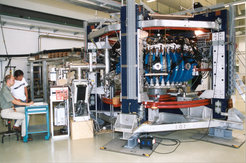WEGA
The WEGA fusion device, a member of the Wendelstein family at IPP, has been in operation since 1975 at various sites with intermittent interruptions.

The WEGA fusion device, a classical stellarator, is a member of the Wendelstein family of IPP. It first went into operation under the name “Wendelstein Experiment in Grenoble for the Application of Radio-frequency Heating” as a joint Belgian-French-German project. Scientists from IPP at Garching and from Centre d’ Etudes Nucléaires at Grenoble had jointly planned, built and operated WEGA.
Then, after a ten-year interlude at the University of Stuttgart, it was started up again in 2001 at the Greifswald branch of IPP. Now renamed “Wendelstein Experiment in Greifswald für die Ausbildung" (Wendelstein Experiment at Greifswald for Training), it was continued there till 2013 and used for training young scientists in basic research, for the investigation of magnetically confined low-temperature plasmas and in testing diagnostics and experiment control for Wendelstein 7-X. WEGA provided first experience with a plasma experiment to personnel at the branch institute established in 1994. New heating antennas, measuring facilities and control systems for Wendelstein 7-X were tested in the readily adaptable WEGA device; it saw completion of two bachelor, two master, thirteen diploma, and six PhD theses. A summary of important results is presented in Stellarator News (11/2006) and Max Planck Society Research Report 2014.
At the age of almost 40 years WEGA is, if not the oldest, certainly one of the long-lived fusion experiments. After its shutdown at IPP, it was passed on in 2014 to the USA at the University of Illinois, where it has since been used for plasma physics and fusion research, under the name HIDRA, “Hybrid Illinois Device for Research and Applications”.
Abstracts of important results can be found in the Stellarator News (Nov. 2006).
